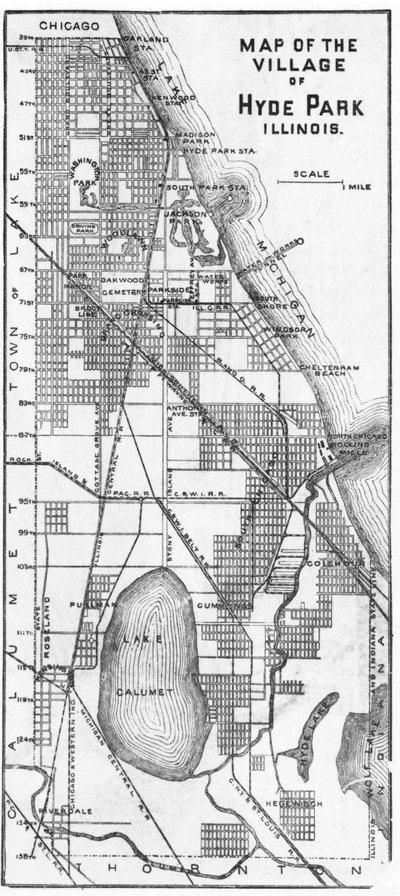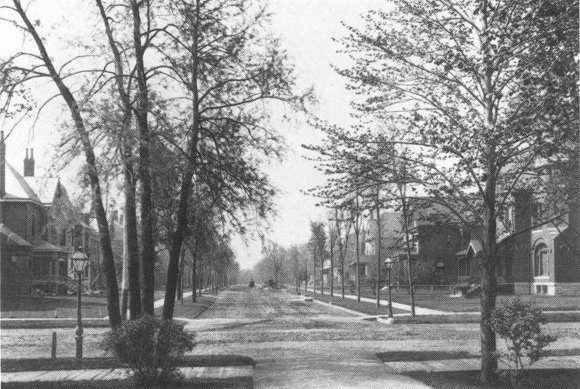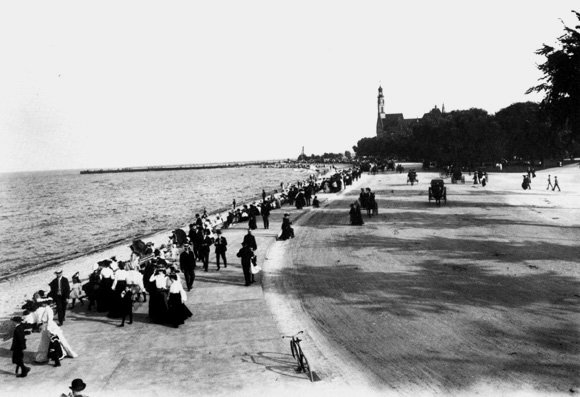The University Neighborhood

1888
Stephen A. Douglas advised Hyde Park's founder. Paul Cornell, "Whenever you have a spare dollar, plant it between [Chicago] and the Calumet. There the future city will lie." At its greatest extent, the municipality of Hyde Park stretched from State Street to Lake Michigan and from 39th Street to the Indiana border.
Hyde Park-Kenwood
Chicago, like other large
American cities, expanded rapidly in population in the late nineteenth
century. Not all of the growth was confined within municipal boundaries.
Taking advantage of swift streetcar and railroad transportation, the
middle and upper classes in increasing numbers abandoned urban neighborhoods
for the comforts of suburban communities established five or ten miles
away from the city's center.
Real estate developer Paul Cornell sensed the importance of this trend and was one of the first in Chicago to promote the lure of suburban life. Planning an ideal commuter village, Cornell bought 300 acres of vacant lakefront land south of Chicago in 1853. Sixty acres were given to the Illinois Central Railroad on the condition that it extend its lines to the new community and build a station at what was to be called Hyde Park. Cornell provided his embryonic village with a church and public parkland. He also built a resort hotel on Lake Michigan at 53rd Street, where vacationing Chicagoans could take in the fresh air and scenery and learn the advantages of purchasing a lot in one of Cornell's nearby subdivisions.
Early residents of Hyde Park and its sister suburb to the north, Kenwood, were quick to provide their communities with the embellishments of a cultivated life. The Hyde Park Literary Society was formed along with the Kenwood Social Club, the Kenwood Tennis Club, the Lyceum, and the Philosophical Society. The Rosalie Music Hall on 57th Street offered a venue for various public meetings, lectures, concerts, and plays.
The opening of the new University of Chicago in 1892 on the southern edge of Hyde Park assured the community of an additional promotional advantage. Like Lake Forest, Evanston, and other Chicago suburbs, Hyde Park could now benefit from the prestige of an institution of higher education.
The increasing attractiveness of Hyde Park-Kenwood led many of Chicago's wealthiest businessmen, including University trustees Martin A. Ryerson, Harold Swift, and Julius Rosenwald, to build impressive homes in the area. They were joined by prosperous middle-class families and by the great majority of University faculty, who were attracted by comfortable homes in an appealing neighborhood within walking distance of the campus. Their houses were frequently designed by firms with distinguished national and regional reputations: Frank Lloyd Wright, George W. Maher, Holabird & Roche, Wilson & Fox, Marshall & Fox, Alfred Alschuler, and Solon Beman among them.


